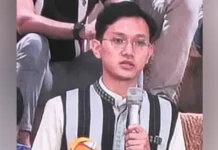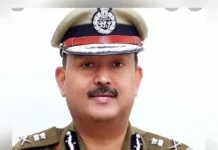[ TT Stephen ]
I saw it myself, with my very own eyes, as I was in the crowd. Naharlagun’s street was like hell in reality. The road was in a shambles, filled with people, iron rods, stones and ashes.
It was Monday, the 25th of February, 2019. Thousands of eyes stared at us as we passed slowly by, a lone vehicle moving through the turmoil-torn town. Our feelings were a mix of wonder and curiosity and fear, although our panic was controlled. At a tri-junction someone shouted, “Maro! Patter maro!” I stretched halfway out of the vehicle and looked back, hoping that they might recognize me and abstain from throwing stones.
What was happening? Where was the head and where was the tail? I could not make out. Among hundreds of people, one was the damned one who raised a stone to throw at any vehicle or army personnel that just moved by. The second was the good person who wanted to stop such an act of savagery and terrorism. The third person was the rumour-monger who wanted to report a thing only to spread rumours and add fuel to the fire. The fourth person was deadly: politics.
There was another group connected with the aforementioned team: three persons – relatives of the first person, the damned one. The second person does not have a friend and is solo. One person is the friend of the third person, the rumour-monger. Two persons are party workers of the fourth person – the deadly poisonous politics.
There was also another group of people, who were in between: three were policemen just roaming around in civil dresses. Five were hungry people looking for food and water. One was a spy of one organisation or the other. One was an opportunist – a thief looking for a chance to snatch something from the spoils; this person broke open doors and lockers and took away valuable things.
There were the remaining 80 persons who were curious and wanted to see for themselves the drama being acted out on the street. These people had nothing to do. If someone fell down, they just looked at him/her, and then passed by, since that person was not known to them. If a house was on fire, they didn’t bother, for the house belonged either to the government or to someone else. All their civic duties were useless. Each one doubted the other.
The paramilitary personnel thought they were rioters. The people whom all their lives they practiced shooting to protect, were now throwing stones at them. The police station was being attacked, and they could not do anything with the guns which had been given to them to protect them. They had no orders to shoot the very people whom they protect. What to do then? The government’s pressure from above them, the protesters’ pressure from their left, and family pressure from their right… until someone fell to the ground from a smoking gun. Whose gun?
It was Monday, the 25th of February, 2019. We pulled into a street and halted there, and left the car.
Takar Complex was up in smoke, and flames were raging in the ground floor. My relative, and two of his relatives, joined the firefighters to stop the fire. There were only two fire tenders, and the smaller truck was shooting water with a 20 mm pipe. It had very little effect on the huge fire.
I called for more fire trucks, but alas, the fire trucks in Itanagar were destroyed by the rioters. Soon, another truck arrived, and now two trucks fired jets of water, as the other truck emptied its water and hurried away to get more water from the river.
When we arrived at the scene, it was 10.15 am. We were relieved to find four other relatives at the scene. But the fear was still in us as the number of curious onlookers increased. A few ITBP personnel blew whistles to disperse the reluctant crowd, and the fire continued without hindrance.
In the ground floor of the building, three blocks were on fire. As the fire trucks put out the flames in the first chamber and continued to do so in the third chamber, the fire in the first chamber reemerged. By 2 pm the fire in the front row of shops was almost put out. Soon we managed to get inside and reach the middle corridor. Four of us, under the choking smoke and heat, and armed with two crowbars, managed to push up the shutters, and the shopkeepers were able to pull out some LPG cylinders and some of their belongings.
Fireman P Pandey, aged 55, was caught with seizure in his legs as there was a muscle cramp. We managed to pull him out, and massaged his legs, which helped him regain circulation. The whole ground floor was heated like an oven. There was also the fear of the wall collapsing upon us. We were not able to open the shutters in order to put out the fire. The only option was to break the walls. The police personnel did not have any fireproof dress. I did not want Mr Pandey and others to go inside. So he gave me his only helmet.
Despite strong opposition from my relatives, I went inside, and started to break the walls. There was fear of fire bursting out, since it had happened in another block a few minutes before. As I did so, the walls opened up, but the flames did not burst forth. When I struck again, the hammer came out of my hand, hit the wall, and ripped the skin off my fingers. A policeman went inside, but came back running as the boiling hot water from the first floor was leaking down.
When the opening was big enough, the firefighter started pouring water. This time they came with an extinguisher, which they said had been borrowed from the Indian Air Force, which had kept it for a helicopter. The Arunachal government was not capable enough to provide to the firefighters one such extinguisher.
At 3.30 pm, I could not find water to drink. By telephonic contact, a relative of mine, a lady doctor at the Naharlagun general hospital, sent a case of mineral water bottles from Papu Nallah. The water bottles never reached us because they had been given away to paramilitary personnel on the way. When one was given, all the others extended their hands, and the little water quenched their thirst.
Another case of water was sent from Rampur Colony in the east of Naharlagun town. That, too, was given away to the military personnel who were fixed on their duty despite hunger and thirst.
We tried several times to open the shutters on the second block of the building, but they could not be opened. Now and then the staff of the building and my relatives and the police personnel went inside in groups of fours, only to come back coughing, with teary eyes. The only option was again to break the wall. The police do not have any blasting materials or wall-breaking equipment. Someone came with a new 8 kilogram hammer, and with it we managed to break the walls.
Now we were divided into three groups, but there were only two fire trucks – one with the 20 mm water pipe canon. One group pulled it to one side, while another pulled it to the other side.
By 5 pm, the whole team was exhausted with hunger and thirst. The team which had gone to get some drinks was held up by protesters, but since these boys were close associates of the protesting party, they were allowed to pass. Since we were greatly in need of drinking water, someone said that even a beer bottle or Pepsi would be equal to water, and so it turned out to be.
Soon, to my relief, Mr Pandey and his teammates were shifted, and a fresh troop of firefighters arrived.
I salute the stamina of 55-year-old Mr Pandey, a major in the firefighting department of the APP, Naharlagun, who did his duty even out of turn, though his duty was on the night shift.
Meanwhile, the fire brigade trucks ran out of diesel. My relative, with two of his relatives, went with the trucks to look for diesel. It was already an hour since they left, and the fires started again. In all, we needed six fire trucks – three to carry water and three to fire water jets to put out the fire. Both trucks stood helplessly, watching the fire, since the lone truck was not returning. After getting the fuel, the truck was again caught up in Model Village area, where the road had been blocked by the rioters again.
The little shower from heaven and the presence of the patrolling army made the crowds disperse. This gave us some inner courage. Determined to put out the fire, we collected water from the gutter in empty Pepsi bottles. By now some good neighbours came out with water buckets. Some neighbours gave us some food at 10 pm. Hundreds of buckets of water were poured and the fire in one of the chambers was put out. By 10.55 pm, the fire trucks came back, and we were all relieved. They continued to pour water. By 1 am, I was completely exhausted, and went up to the car to rest. As I dozed off, I left the door slightly open, and the silence of the night took me into deep slumber while mosquitoes feasted on my blood.
At 3 am, my relatives came up to the car, and I asked if the fire had been put out. They said yes. We came away from the scene in two cars. There were no protesters in between Naharlagun and Itanagar, and we reached our homes.
The 17-hour stretch is gone, but the fight with the fire will be remembered. I salute every firefighter of the Naharlagun APP fire department, the policemen in civil dresses who were with the team, the shopkeepers, the neighbours of Takar Complex, my relatives, and my friends.
I also thank you, all the onlookers who recognized us and stopped the attackers who wanted to attack us. You were that one person who was in the category of goodness. May god bless you all.
At this time, when India is destroying the terrorists, we are destroying our own properties. Though the fire was not put out completely till the time of writing, the effort was memorable. Your effort will be in my heart as long as I live. Thank you all.





